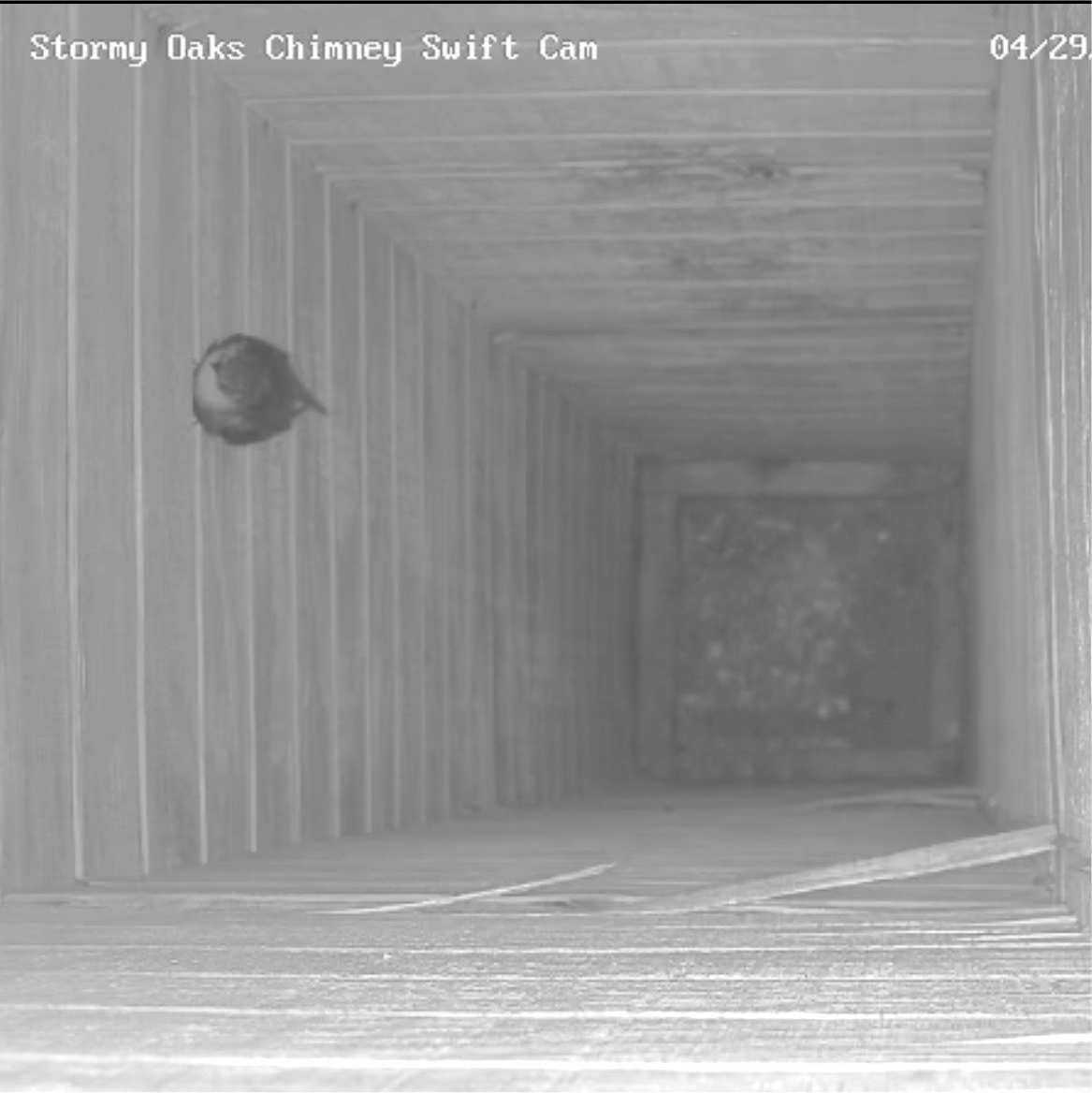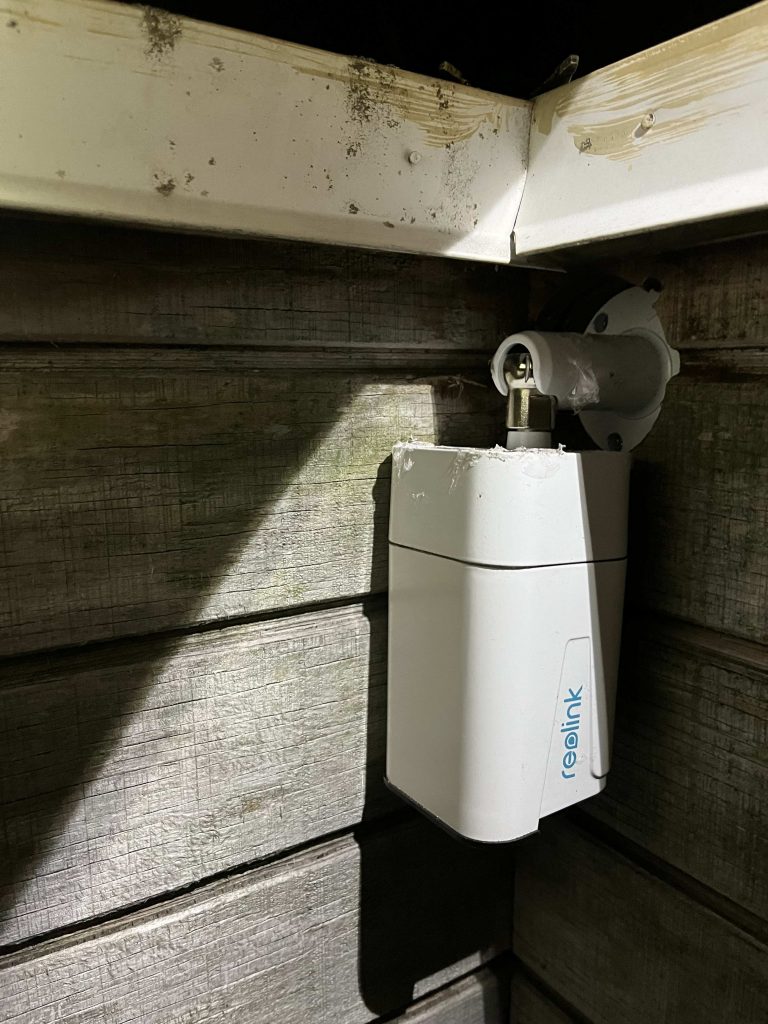
Newly Installed Camera Highlights Chimney Swifts
Jim Kellam, PhD. Associate Professor of Biology
Saint Vincent College
PixCams is hosting a Chimney Swift Cam! Link to live stream: https://pixcams.com/chimney-swift-cam/ Not only is this the first time for us, but our setup appears to be one of a kind. I have searched the internet looking for other livestreaming cameras focused on Chimney Swifts, and I cannot find any others currently operating. This is a unique opportunity to view the lives of these unusual birds from inside a specially built chimney tower used for nesting and roosting. I’ll start this blog post first with the biology of Chimney Swifts, and then answer the question of why they use an artificial structure for shelter. Then I’ll explain what we might observe on this camera over the next year.
If you live in North America, you have seen Chimney Swifts many times whether you knew it or not. They are the bat-like birds that flutter overhead in open areas, busily chirping and swooping, never flying in the same direction for more than a few seconds. They are almost always in flocks when you see them and given their continuous motion in every conceivable direction it is a wonder that they don’t collide with one another. The birds look like bats, they sound like bats, and they eat flying insects like bats. They can also cling to vertical surfaces like bats (always upright, though). Despite these similarities, of course, they are birds and not mammals. They have an ancient lineage, having evolved 50 million years ago from an ancestor they share with hummingbirds.
Chimney Swifts do not perch on horizontal branches like other birds, nor do they walk on the ground. Instead, they are constantly in flight during daylight hours. Even sex may occur in midair! The legs are held close to the body and are adapted to helping the birds cling to vertical surfaces like the inside of chimneys, caves, and hollow tree trunks. Indeed, the original nest locations for swifts were the insides of hollow trees. Nests are made of small sticks glued with saliva to a vertical surface in a half-basket shape. As Europeans settled in North America, they felled most of the large trees—the ones most likely to have hollow sections, and today, hollow trees in urban and suburban areas are usually cut down for safety. This could have caused a significant decline in swift populations except for something that started happening at the same time as European settlements: the building of structures with chimneys! Chimney Swift populations likely increased several hundred years ago with the addition of chimneys, and this still explains why today more swifts live in urban areas than in rural areas.
The camera we set up is in an artificial tower constructed more than a decade ago for the sole purpose of attracting Chimney Swifts. It is located on the grounds of Stormy Oaks Nature Conservancy in Valencia, Pennsylvania (https://www.wildbirdrecovery.org/). There is a suburban housing development being constructed a quarter mile away, but otherwise, the aerial view of the site shows equal portions of agricultural fields and woodland patches. Stormy Oaks has been operating Wildbird Recovery, Inc., on the property for many years, and the wildlife rehabilitation staff there have developed a special affinity and expertise in the care of injured Chimney Swifts. I volunteer there, and on any given day when I visit, I can walk into the rehab room and find swifts hanging contently from a cloth-draped tube where they receive their care. They are not startled at my towering presence. They just stare with small eyes—in fact, small everything!—and wait for their next meal. It must be hard for an injured swift not to fly, since that is what they’d normally be doing.
The artificial tower outside the rehab building is for healthy birds and not the injured ones being cared for by the staff. As I write this, wild Chimney Swifts are in the midst of their northward migration from wintering grounds in South America. We are starting to see flocks of them flying overhead, and some of these will settle here to breed, while others will keep flying north into southern Canada. While on migration the swifts will form flocks of 50-1,000 individuals and together seek shelter inside a chimney at night. The birds dive head-first into a shaft and then somersault in midair to point their tails down and grab hold of the surface with strongly gripping feet. They will use the same shelters along their migration route if available. Once they arrive where they intend to breed, pairs of swifts will select a chimney or other suitable structure for their nest site. Does this mean they have exclusive use of the chimney? Interestingly, no. They tolerate other swifts inside the chimney at night while everyone sleeps. However, only one pair will nest in a chimney at once. For this reason, we may see swifts build a nest here on our livestream and see them incubate eggs and feed young during the day. But then at night, there may be a small number of non-breeding swifts that enter and roost in the structure in addition to the nesting pair. This may be just a handful of non-breeding swifts at first, but as spring turns to summer, and surrounding parents finish up with their own nests, the flock of birds roosting in the chimney will grow.
As summer turns to early fall, the Chimney Swifts will begin migrating south, and the chimney will no longer host birds after mid-October.
This Chimney Swift Cam was a joint effort among Wildbird Recovery, Inc. at Stormy Oaks Nature Preserve, PixCams, and the Biological Sciences Department of Saint Vincent College (www.stvincent.edu). I am sure that I speak for all of us in saying that we hope the camera provides joy and learning opportunities to all who view it. The Chimney Swift population is not in good shape. It has declined by 67% since 1970. The cause of the decline is not fully understood but it is believed to be due to decreased availability of insect prey. For this reason, building more chimneys is a valuable undertaking to provide shelter to existing individuals, but the more effective solution will be to protect the insects and their habitats throughout the western hemisphere, since the swifts need food on their wintering grounds, their breeding grounds, and everywhere in between. Our camera cannot assist with this directly, but it does help spread the word that these birds are special and that they deserve our care and support.
References:
Maryland Bird Conservation Partnership’s Chimney Swift Conservation Program, https://marylandbirds.org/chimney-swifts
Steeves, T. K., S. B. Kearney-McGee, M. A. Rubega, C. L. Cink, and C. T. Collins (2020). Chimney Swift (Chaetura pelagica), version 1.0. In Birds of the World (A. F. Poole, Editor). Cornell Lab of Ornithology, Ithaca, NY, USA. https://doi.org/10.2173/bow.chiswi.01
Watson, T. (2013) ScienceShot: Fly Like a Hummingbird, Glide Like a Swift. https://www.science.org/content/article/scienceshot-fly-hummingbird-glide-swift


I do not even understand how I ended up here, but I assumed this publish used to be great
The writing is both informative and engaging. ❤️
I just could not depart your web site prior to suggesting that I really loved the usual info an individual supply in your visitors Is gonna be back regularly to check up on new posts
I very delighted to find this internet site on bing, just what I was searching for as well saved to fav
Nice blog here Also your site loads up very fast What host are you using Can I get your affiliate link to your host I wish my site loaded up as quickly as yours lol